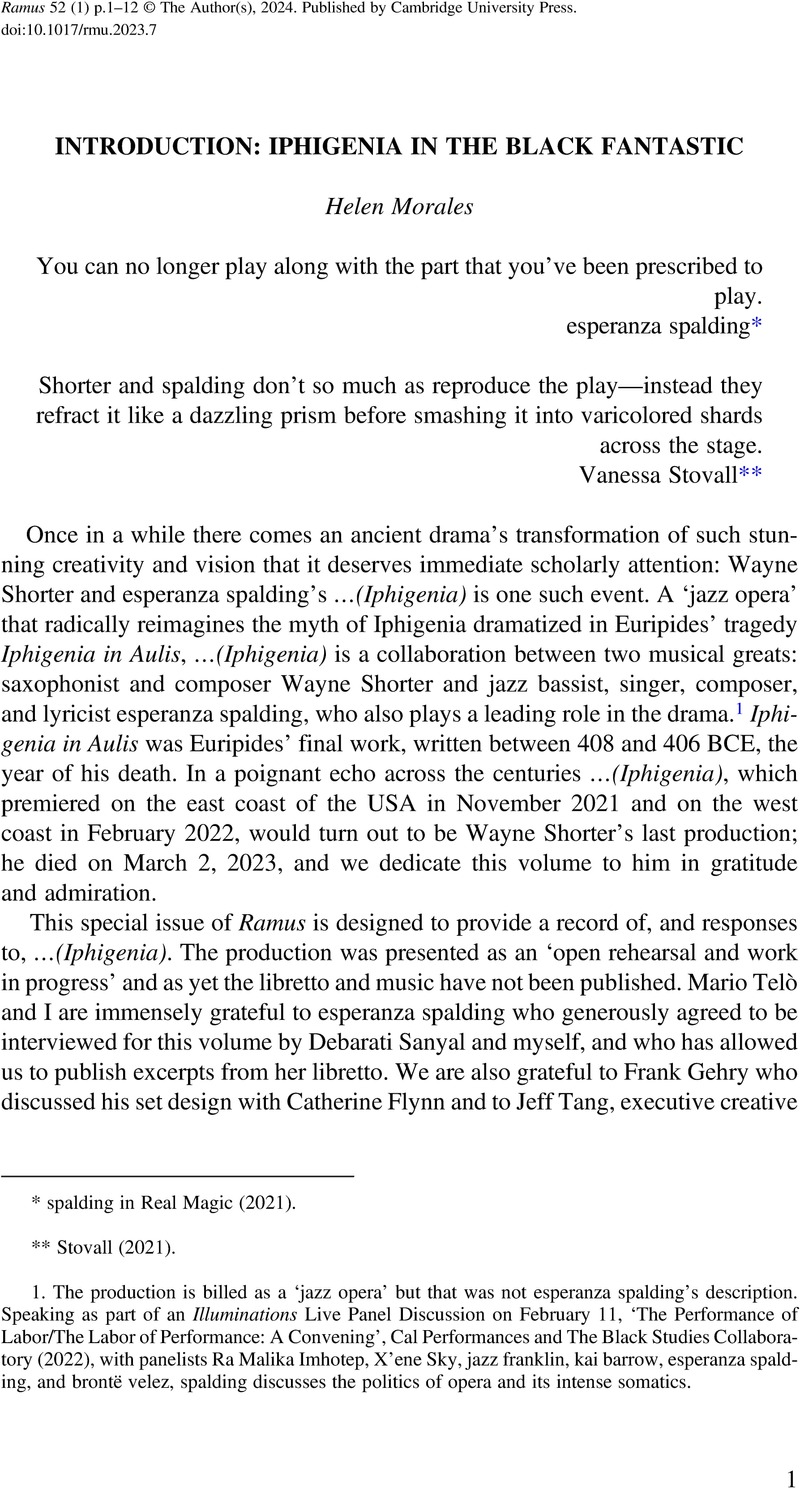No CrossRef data available.
Article contents
INTRODUCTION: IPHIGENIA IN THE BLACK FANTASTIC
Published online by Cambridge University Press: 24 January 2024
Abstract

- Type
- Introduction
- Information
- Ramus , Volume 52 , Special Issue 1: Wayne Shorter and esperanza spalding's …(Iphigenia): Interdisciplinary Approaches , June 2023 , pp. 1 - 12
- Copyright
- Copyright © The Author(s), 2024. Published by Cambridge University Press
References
* spalding in Real Magic (2021).
** Stovall (2021).
1. The production is billed as a ‘jazz opera’ but that was not esperanza spalding's description. Speaking as part of an Illuminations Live Panel Discussion on February 11, ‘The Performance of Labor/The Labor of Performance: A Convening’, Cal Performances and The Black Studies Collaboratory (2022), with panelists Ra Malika Imhotep, X'ene Sky, jazz franklin, kai barrow, esperanza spalding, and brontë velez, spalding discusses the politics of opera and its intense somatics.
2. Braidotti (2022), 9, on transversal ways of thinking. For reflections on what kind of scholarship is valued in the discipline of Classics and how traditional forms of knowledge production can perpetuate white supremacy, see Eccleston and Padilla Peralta (2022).
3. Stovall (2021).
4. See Gurd (2005), and more generally on the play and its reception see Michelakis (2006).
5. Gurd (2005), 9. See also Wohl (2015) on action, agency, and aporia in the tragedy.
6. See Goldhill (2010), 60, on how this model of conceptualizing the classical tradition is ‘invested with Victorian intellectual and social anxieties’, and further, 69, on why ‘the diffuse, collaborative, multi-levelled nature of performance as an event cannot be reduced to the model of an individual artist nurturing an aesthetic response to an artwork, or responding to the ancient world through an artwork’.
7. Solga (2008).
8. Telò (2023). See also his comments on the ramifications of the reversal of masking that seeing a theatrical performance during the pandemic involved (actors were unmasked, audience members were masked), on temporality and the ‘stuckness’ of the characters in the drama and people living through the pandemic, and on the ethics at the heart of the play and political contexts: ‘Iphigenia's final gesture, her sudden acquiescence to the patriarchal solution, sacrificing herself for the community—whether fulfilled or forestalled at the last moment—aligns itself with the bio- and necro-political discourse on the disposability of certain lives that became shockingly explicit at the outbreak of the pandemic.’
9. Politics 1252b8, quoting Iphigenia in Aulis line 1400.
10. Gerolemou and Zira (2017), 70–2.
11. Hartman (2019).
12. See also Caridad Svich's (2012) multimedia play Iphigenia Crash Land Falls on the Neon Shell That Was Once Her Heart (A Rave Fable) which reimagines Euripides’ Iphigenia in Aulis (and Racine and Gluck's adaptations of the tragedy) in relation to the femicides committed in Ciudad Juárez, Mexico.
13. As told in Hurston (1943).
14. Eshun (2022).
15. Eshun (2022), 12. The Black fantastic, according to Eshun (2022), 11–13, eschews the sardonic tone of magic realism, and some of the limitations of the genre of Afrofuturism.
16. Eshun (2022), 13, quoting Commander (2017), 24.
17. The life of St Ephigenia originated in the apocryphal tales about St Matthew. A notable account is found in the Legenda Aurea by Jacobus de Voragine in 1275 CE, and her story is also told in the body of work created by a small group of Belgian Jesuits in the seventeenth century known as the Bollandists. St Ephigenia was said to have been a young Ethiopian woman (though there is no independent Ethiopian tradition about the saint), the daughter of a king, who was renowned for her purity and chastity. She is still venerated today, especially in Afro-Peruvian communities: see Sánchez (2012) and Rowe (2019). In his hagiographic play San Mateo en Etiopía, the seventeenth-century Portuguese dramatist Felipe Godínez fuses the myths of St Ephigenia and Iphigenia: see Márquez Martínez (2017). I am grateful to Charles Kuper for discussion of this topic.
18. Smullen (2021).
19. Butler (2004), 133, quoted and discussed in Solga (2008), 157f.
20. My thoughts in this paragraph have been influenced by Kim Solga's article on Katie Mitchell's 2004 production of Euripides’ Iphigenia in Aulis at The Royal National Theatre in London, which I also saw. See Solga (2008).
21. Edna O’ Brien's play Iphigenia in O'Brien (2003); Colin Teevan's (2002) play IPH…. Elizabeth Cook's prose adaptation (2006) foreshadows Clytemnestra's revenge (‘If he kills you, I will kill him’, 409), but focuses on Iphigenia's relationship with her mother and her ambivalence about her maturing body.
22. Though see Telò (2020a) on how Greek tragedy resists catharsis.




